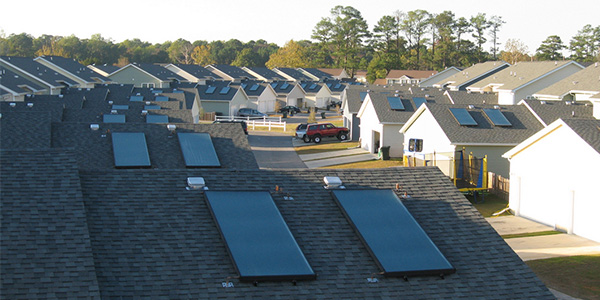The future of net energy metering ― and how solar owners should be compensated for the power they put back on the grid ― begins with asking the right questions, says Mohit Chhabra, senior scientist at the Natural Resources Defense Council.
“We often talk about net metering as an absolute, when the question really is: net metering and what?” Chhabra said during a panel discussion on NEM on Feb. 9 at the National Association of Regulatory Utility Commissioners Winter Policy Summit. “What is the value of solar in my region? What are your energy and climate policy goals? Once you’ve determined that value of solar, how do you best reflect that in a way that’s easy to understand and manage in rates?”
First introduced by states when rooftop solar costs were high, NEM was intended to help residential customers offset their upfront costs by paying them retail electricity rates for their excess power. NARUC said in a FERC Rejects Net Metering Challenge.)
The issue now is not whether the incentive needs to change, but how, a theme echoed at a previous session at the Policy Summit. (See Net Metering Successors Need ‘Holistic Approach’.)
“It’s really a blunt instrument,” said Emily Fisher, general counsel and corporate secretary at the Edison Electric Institute, the trade association for investor-owned utilities. “It needs to be refined because the value that rooftop solar provides is really dependent on where it is and when it’s being used.”
She reframed the question for the panel: “How do we make it the most useful tool possible for accomplishing the goals we collectively have?”
A Mature Technology
Vermont provides a case in point. Net metering has driven a thriving solar industry in the state, where incentives are available not only for small rooftop installations but for commercial projects up to 500 kW, Vermont Public Utility Commissioner Sarah Hofmann said. The state also offers additional incentives for projects built in “preferred locations,” such as brownfields or parking canopies, she said.
About 30% of the state’s peak load now comes from net-metered solar, Hofmann said, but that success has come with problems. As in other states, Vermont utilities argue that net metering has shifted fixed costs for transmission and distribution from net-metered customers to those without solar, many of them low-income consumers. Bottlenecks are also occurring in remote areas of the state where new solar projects cannot export power without jeopardizing the grid, she said.
NEM “does have to change and evolve. Basically, [solar] is a mature technology at this point, and you make different regulatory decisions when something has matured.”
Vermont’s most recent revision to the NEM compensation structure — the fourth since 2017 — will see residential rooftop rates step down from 17.4 cents/kWh to 16.4 cents and later in the year, to 15.4 cents.
Incentive or Price Signal?
States with strong solar markets have rolled out a range of NEM successors, underlining the diverse, regional nature of possible alternatives. California has retained retail NEM but tied compensation to time-of-use rates.
Customers get a lower payback for excess solar put on the grid at mid-day, but pay higher, peak rates for power they use from the grid in the late afternoon and evening. As a result, the residential storage market has been growing in the state, allowing solar customers to store their mid-day power and either use it or put it back on the grid later in the day. The California Public Utilities Commission is now working on another update, NEM 3.0.
Hawaii, which has the highest penetration of rooftop solar in the nation, ended retail rate net metering in 2015. The state has since introduced tariffs that encourage customers to consume as much of the power they produce as possible, or limit the amount they can export, again raising consumer interest in residential storage.
Most recently, the Arizona Corporation Commission approved a technology-agnostic compensation plan for a range of DERs. Rates are based not on specific technologies, but on the resources or services they provide to the grid. (See States Working out Details of 100%.)
Kevin Lucas, senior director of utility regulation and policy at the Solar Energy Industries Association (SEIA), said the initial successes of net metering in high-penetration markets underline why it should be retained in states where residential solar is still in its early stages. While acknowledging that changes are needed, he said, the rules should be kept simple, especially for residential and small business customers.
The residential solar market is itself resilient, adjusting to changes in net metering rates and the COVID-19 pandemic ― a point often unacknowledged in policy discussions like those at NARUC. According to the most recent market report from Wood Mackenzie and SEIA, after a pandemic-related drop in the second quarter of 2020, residential solar has rebounded, and some installers are reporting strong pipelines. The two-year extension of the 26% federal investment tax credit for solar, enacted in December, should also help maintain market growth. (See Wind, Solar, EE, CO2 Storage Win Tax Breaks.)
Going forward, rate and NEM redesign will require balance, tradeoffs and keeping all policy options open, Lucas said.
“When you get to very high levels of penetration and you start to focus on how do we deeply decarbonize the system, you start to have some unique trade-offs that you might not have had. The picture changes a bit as you advance,” he said.
“It’s good to remember that net metering isn’t the only way to promote solar,” Chhabra added. “Additional incentives could be built into rates. It’s striking the right balance between sending more accurate price signals and sending the right level of support and having the right policies in place.”




